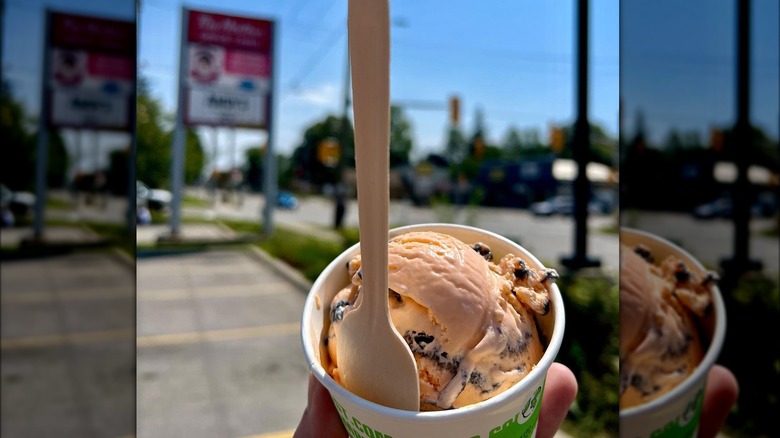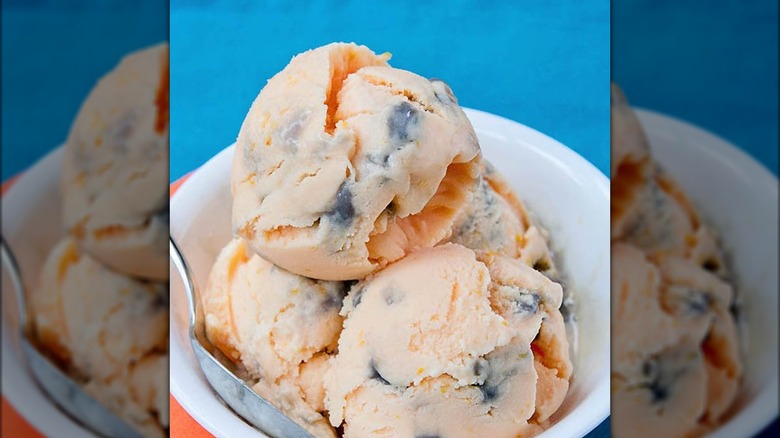How Tiger Tail Ice Cream Became A Canadian Classic
Mention 'Canadian cuisine' to most Americans, and the dishes that come to mind are easygoing comfort foods, such as poutine (French fries doused in gravy and topped with cheese curds — or, our favorite, brisket poutine), Canadian bacon (and no, Canadian bacon isn't ham), bannock bread, or Nanaimo bars (chocolaty, cream-filled bar cookies). But another beloved favorite in Canada –- especially among those who came of age in the 1950s and 60s — is virtually unknown in the U.S.: tiger tail ice cream.
The confection (which is completely tiger-free) is a unique combination of creamy orange-flavored ice cream with a black licorice swirl, and its name comes from its striking orange-and-black color. It first emerged in the 1950s and many credit a woman named Morgan Carr as its inventor – though little is known about her or what inspired her idea. What we do know, however, is the unusual flavor became wildly popular in Canada in the 1950s and 1960s before falling out of fashion in the 1970s. Today, it's known as a regional specialty of southern Ontario and a nostalgic taste of a bygone era.
Tiger tail ice cream has both devoted fans and haters
Perhaps a reason tiger tail ice cream never caught on south of the Canadian border is that its distinctive taste isn't for everyone. Black licorice, one of its key components, is polarizing in itself, and its presence in tiger tail ice cream may be a deal-breaker for some ice cream lovers. "You either love it (like myself) or hate it (like everyone else I know)," a Reddit commenter noted in a thread on the flavor.
But its fans swoon over its combination of fruity, floral, and botanical notes, which they find a delightful match for the creaminess of the ice cream base. "The [flavor] captivates taste buds with the wide spectrum of its taste profile[,] and you want to have more right away," Lesya Chapman, marketing director for the Canadian ice cream manufacturer Chapman's, told Food Network Canada. "People who love it are very loyal to this [flavor]."
Still, the reality is that tiger tail superfans are a shrinking tribe — but what they lack in numbers they make up for in passion. Despite the flavor's diminishing popularity, Canadian manufacturers keep making it "because loyal tiger tail fans raise an enormous fuss whenever its future appears in jeopardy," Chapman's Vice President Ashley Chapman told The New York Times.
Not in Canada? Try making your own
While several manufacturers and small ice cream parlors still offer tiger tail ice cream in Canada, you're unlikely to find it in a stateside grocery freezer or ice cream shop. So if you're curious to try it without leaving the country, your best bet is to break out your ice cream maker and whip up a batch yourself. Both nostalgic Canadians and curious American cooks have devised recipes for the treat, including vegan versions.
Start with a simple vanilla ice cream recipe, but add a dash of orange extract and some orange food coloring. Then, make a caramel sauce but add in a few teaspoons of anise extract and some black food coloring (or activated charcoal) for that striking swirl. Churn your ice cream, add in your caramel, and there you have it! Or, for an even easier way to get those beautiful stripes, you can just melt down some black licorice candies with some water for a simple anise-flavored caramel.



